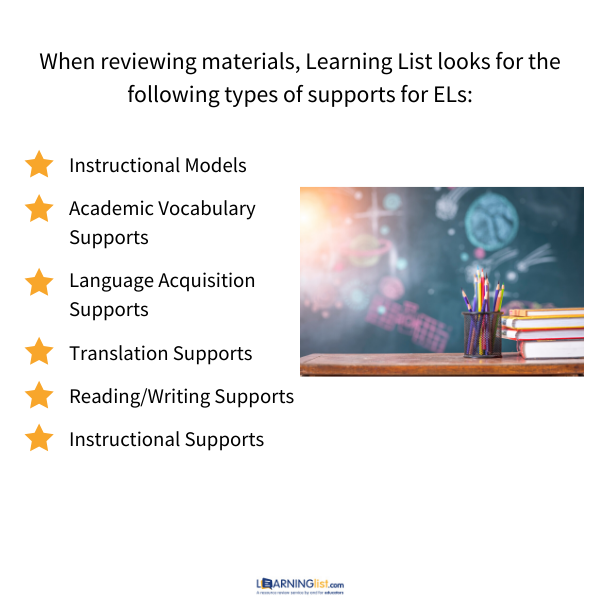
Districts increasingly are contacting us for assistance finding high quality materials to support ELs. Whether, and if so, how materials support ELs is part of Learning List’s quality review rubric. Having reviewed thousands of materials, we have observed seven trends in how instructional materials address the needs of ELs:
- The availability of materials designed specifically to support language acquisition and development is limited, as is the number of materials available in languages other than English. There are significantly more materials that support language acquisition at the elementary level than there are for secondary students. As a result, districts often choose reading intervention programs, which are generally provided in English, as support for their secondary EL students. These materials, however, do not typically support students’ acquisition of content knowledge in subjects other than English Language Arts.
- Materials for elementary ELA/R generally provide instructional strategies to support ELs but may lack the level of systematic, explicit instruction in foundational skills that ELs need. Research has proven that explicit, systemic instruction of foundational skills is best for most students, and it is vital for ELs.
- Materials that include a significant amount of digital content tend to provide more language adaptions than print-only materials. If publishers of digital materials offer to print content to meet a district’s needs, districts should be aware that the printed copies may not contain as many EL supports as the digital version contains.
- Comprehensive materials provide adaptions more often than supplemental materials do. Few materials provide EL-specific supports or adaptions, even if they are labeled as such. Comprehensive materials that have supports, commonly only provide general instructional strategies or adaptions to support any special population. For example, an instructional material might suggest that teachers front-load vocabulary instruction or that they work with students in small groups. Generalized adaptions might include a bilingual glossary or screen readers.
- Materials with strong support for English Learners provide instructional suggestions or adaptions to content based on students’ levels of English proficiency. For example, an ELA/R product we recently reviewed allows the teacher or student to adjust the complexity of reading selections based on level of English proficiency. A science product we reviewed provides language acquisition strategies that address listening, speaking, and reading. Other products provide instructional suggestions, such as scaffolded suggestions for teaching academic vocabulary that are specific to the students’ level of English proficiency.
- Few materials provide translation support for ELs whose native language is something other than Spanish. When translations are present, they are most often provided for Spanish speaking students. We have seen only a handful of instructional materials that support instruction in additional languages. One digital product we have reviewed provides the content in more than 15 languages.
Given the demographic trends in the United States, it is likely that the number of English Learners and the variety of languages spoken in our schools will continue to increase for the foreseeable future. As a result, there will continue to be a significant need for quality instructional materials. At Learning List, we will continue to be part of the conversation and part of the solution by continuing to review materials for the supports EL students and the teachers who serve them need to be successful.
9 thoughts on “7 Trends in Materials’ Supports for English Learners”
Comments are closed.